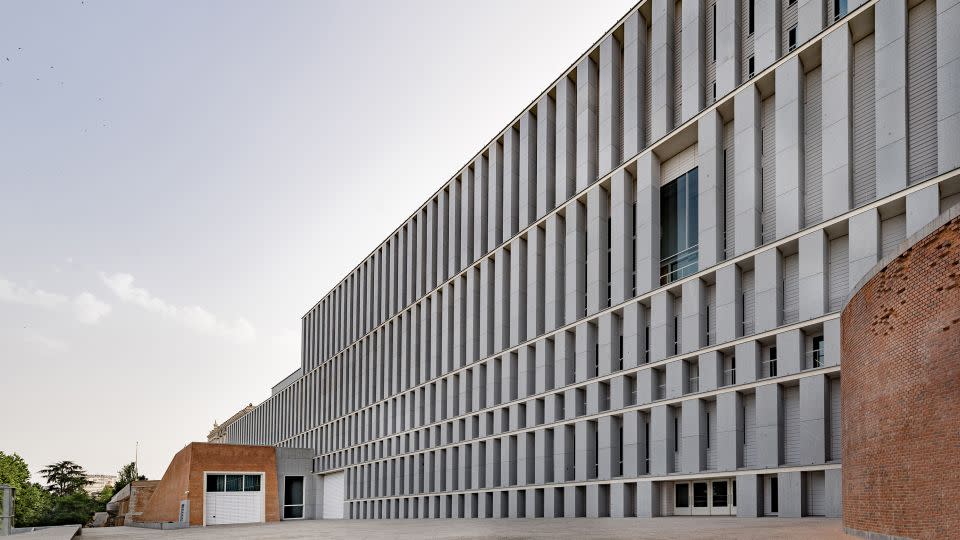After 25 years and $185m, Spain’s new Royal Collections Museum is finally opening
- Oops!Something went wrong.Please try again later.
When the Guggenheim Museum Bilbao opened in northern Spain 25 years ago, architect Frank Gehry’s curvy titanium-clad building was itself as much a part of the attraction for many art lovers as the exhibits inside.
As Spain opens the long-awaited Royal Collections Gallery in Madrid next week, its sleek new eight-story building, perched on an iconic hillside next to the Royal Palace, may also steal some of the attention from the Old Masters on display. Spanish architects Emilio Tuñon and Luis Mansilla won the 2017 American Architecture Prize and a dozen other awards for this design, built with white concrete, granite and oak and featuring hundreds of windows overlooking the leafy gardens below the Royal Palace and the expansive Casa de Campo park beyond.

The new museum, costing €172 million ($186.8 million), opens June 29 with 650 works spanning five centuries on show, including masterpieces by Velazquez, Caravaggio, Goya and a first edition of Cervantes’ “Don Quixote.” It’s a “representative” selection of the 170,000 paintings, sculptures, tapestries and decorative arts usually distributed among the 19 palaces in Spain and other royal sites managed by Patrimonio Nacional (National Heritage), the organization’s president Ana De la Cueva told CNN during a tour of the gallery last month.
Patrimonio Nacional is a government body that oversees palaces, monasteries, convents and their extensive art collections which used to belong to the crown, but now pertain to the Spanish state.
A new home for rarely seen artworks
Some works on display at the new museum have never before been seen by the public.
One is “Saint Michael the Archangel Defeating the Devil,” a wooden sculpture completed in 1692 by Luisa Roldan, the first woman appointed as a Spanish court sculptor.
There are just three works, among the 650 on display, signed by female artists, Leticia Ruiz, director of the Royal Collections, told CNN via phone. In the 16th and 17th centuries, Ruiz explained, it was uncommon for women to sign artworks with their own names because men — usually husbands or fathers — held the title of artist or artisan and therefore took the credit. The true number of works displayed by female artists is unknown.

“The fundamental thing about Roldan was her quality, which allowed her to escape anonymity and become head of the workshop, ranked higher than her husband,” Ruiz said. “It’s likely that there were many other women in family (artist) workshops. But who remained anonymous.”
Another unseen work — previously hidden away in the adjacent Royal Palace — is Diego Velazquez’s “White Horse,” dated 1634-1638. In the painting, the titular horse rears up on its hind legs, but unusually, without a rider. “That’s what’s fascinating about this work,” Ruiz said, adding that Velazquez could have painted the horse first, ready to paint a rider — likely a royal — upon it later.
Caravaggio’s “Salome with the Head of Saint John the Baptist,” dated 1607, is also included in the collection, one of just four Caravaggios that reside in Spain.
A ‘spectacular’ new building
“A modern building with sober lines, spectacular in dimension,” said de la Cueva of the new building during a tour of the gallery earlier this month. “The combination of classic art and the Baroque against these lines is very powerful.”
The idea for this museum began in the 1930s during Spain’s Second Republic but didn’t gain traction until 1998 when the building was green lit. Studies prior to construction had shown defensive towers built by the Moors, as well as a portion of the ninth-century city wall, and these were quickly discovered when works began in 2006.
These Islamic roots of early Madrid have been restored and are a key part of the museum’s exhibit, which visitors can view through a large glass window. “In this space, the oldest part of Madrid has been integrated with the most modern, in this marvelous building of the 21st century,” De la Cueva told reporters during a press conference last month.

The exhibits are in long rectangular galleries with high ceilings, arranged chronologically on three levels, including the period of the Spanish empire with its hefty purse for commissioning works from great artists. The exhibit starts with the Hapsburg monarchs’ royal collections — located near the old city wall exhibit — and then one level below, the Bourbon dynasty collections.
On a floor below that are the temporary exhibitions, which start with carriages from the Royal Collections and some on loan from other institutions, Ruiz said. Tapestries that often traveled with the monarchs as they went from one of their palaces to another are well represented in the museum.
One is “Triumph of Time,” an early-16th century Flemish tapestry that Queen Isabel the Catholic later sold, and which the Spanish government recently bought back from a private collection, for just over a million dollars (€1 million euros), Ruiz said.
A third of the museum’s 650 items will be rotated annually back to the royal palaces and other Patrimonio sites and replaced with other items from their collections.
With views out over the same vast expanse of greenery west of the Spanish capital as might also be seen from the western-facing windows of the nearby Royal Palace, visitors may be forgiven if they leave feeling a little more regal than they went in.
For more CNN news and newsletters create an account at CNN.com

